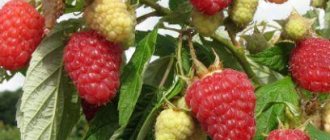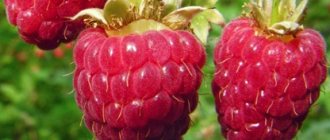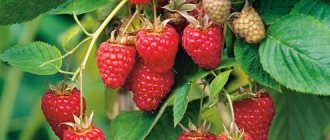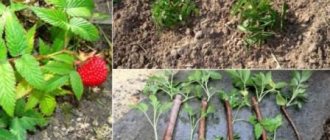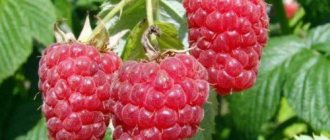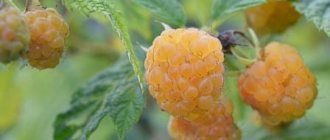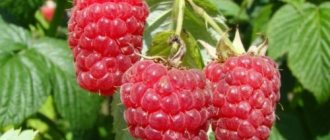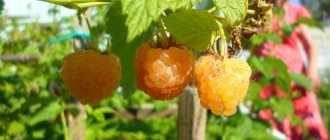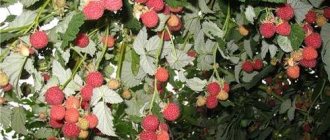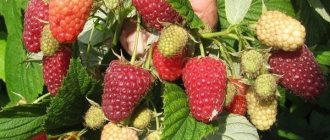Raspberry Yellow Giant is a large semi-remontant yellow-fruited variety, the most popular of all yellow varieties. Tasty, healthy and aromatic berries are in no way inferior to classic red-fruited varieties.
AGRO PREMIUM is an innovative, environmentally friendly plant activator, without chemicals, that protects berries, fruits and vegetables from pests and diseases, increases seed germination, stimulates root formation and plant growth, and significantly increases productivity.
At first glance, it may seem that only a professional can grow such a variety, but no. Even a beginner in gardening can grow yellow raspberries; the main thing is to follow the rules of planting and caring for the yellow-fruited raspberry variety.
Raspberry Yellow giant: remontant or not
It would be more correct to call it a semi-remontant variety. With good care, the variety shows signs of remontancy. In September, juicy sweet berries can ripen on the upper third of annual shoots.
The shoots are not cut out completely, as in completely remontant varieties, since next year the Yellow Giant raspberry enters the phase of its main abundant fruiting.
As a result, you can harvest several times per season; you can collect about seven kilograms of berries from one bush.
When is the harvest harvested?
The Yellow Giant raspberry harvest begins in July. It is at this time that the first berries ripen. Of course, the hotter the climate and the warmer the summer, the faster you can enjoy the delicious fruits. The last harvest occurs around October.
Important! In the middle and northern regions, in early winter, there may not be a second harvest at all, since frosts will make normal ripening of the berries impossible. Often green raspberries already appear on the bushes, but they simply do not have time to ripen.
After harvesting, Yellow Giant raspberries can remain for another 4 days, then quickly deteriorate and rot. During these 4 days you need to either eat it fresh, sell it, or process it. The variety can make very tasty and healthy jam for the winter, compote, jam. Sometimes they freeze it, in this form, fresh, thawed berries can be eaten even in January or February! They will not lose their taste, but, unfortunately, they will not be able to keep their previous shape.
After harvesting, Yellow Giant raspberries can remain for another 4 days, then quickly deteriorate and rot.
The berries of the Yellow Giant have proven themselves well in baked goods, desserts, and fresh juices. But, of course, most often they are simply eaten fresh. It is fresh raspberries that contain the greatest amount of nutrients and vitamins. The berries of this variety are so sweet that they are given to children instead of sweets and sweet pastries. They are good for the body, do not cause allergies, and are excellent disease prevention.
Advantages and disadvantages
The yellow giant has many advantages over red raspberries. One of them is the lack of anthocyanins. Thanks to this, yellow raspberries are suitable for allergy sufferers, pregnant women and small children. Yellow varieties have a higher sugar content, which is why their berries are sweeter and tastier.
Another main advantage of the Yellow Giant is that it is highly winter hardy and is less likely to be affected by diseases.
The only drawback of this variety is that it cannot be stored for a long time. Therefore, yellow raspberries are most often used for canning.
Varietal characteristics
This variety is mid-season; in the middle zone, the berries begin to ripen around July 10. The shape of large, up to ten grams in weight, berries is blunt-conical with barely noticeable roundness. The berry itself hangs on a four-centimeter long thick petiole.
On a note! Yellow raspberries are very sweet with a slight sourness, which is less pronounced than in red varieties. It is excellent for fresh consumption and processing, but it is stored very poorly, so it is advisable to eat it within a short period of time after collection.
When describing the “Yellow Giant” raspberry variety, it is necessary to mention that the bushes of the plant correspond to the name. They reach a height of two or even two and a half meters, which entails the installation of a support or trellis for tying up bushes.
Site selection
Yellow raspberries love sunlight, so a place for planting them should be allocated in the sunny part of the garden. Raspberry is a moisture-loving plant, but does not tolerate stagnant water.
More on the topic: Frost-resistant Altai raspberries Tasty
The optimal direction of the Yellow Giant rows is from north to south. In this case, each shoot will receive the share of heat and light necessary for development. The site should not be located in a lowland or at a high elevation.
Under no circumstances should the Yellow Giant be planted on old raspberry beds. Not only is the soil there severely depleted, but pests can also be inherited.
Agricultural technology
Like any fruit and berry crop, raspberries love good care, for which they later thank their owners with a good harvest. First of all, it is necessary to properly plant the bushes, feed the soil and take care in the autumn to create favorable conditions for wintering.
Video: Raspberries of the Yellow Giant variety
Selecting a location
For planting, choose a well-lit, sunny area where the raspberries will be protected from the wind. The ideal option would be flat terrain without a slope.
Important! It is advisable to plant raspberry bushes in rows located from north to south
-
this way they will be illuminated as much as possible throughout the daylight hours.
Raspberries can suffer from high soil moisture, so for planting they choose an area where there is no upper groundwater. You cannot plant bushes in a place where raspberries have already grown before - here the soil will be poor and depleted, which will lead to poor yields. Such areas require rest, the period of which is about 5 years. It is also not recommended to plant the crop after any nightshade - both have a tendency to develop verticillium wilt, which means that a new planting may become infected.
Planting and care
The yellow giant can be “settled” on the site in autumn or spring, but given that the variety begins its growing season early, it is better to carry out work in early September . The most successful method of planting a plant is trench. In this case, planting pits are prepared a month in advance.
Find out more about the features of planting raspberries in the fall.
Landing is carried out according to the following algorithm:
- Dig a trench up to half a meter deep. The length will depend on the number of bushes being planted, since the distance between them should be 70–90 cm (if there are several rows, there should be a gap of at least 1 meter between them).
- Along the edges of the trench, a fence is made of slate or other sheet material, which should be dug to a depth of 10–15 cm - this way the shoots will not be able to grow.
- Place organic fertilizer at the bottom of the trench, filling it one-third full. A set of components such as rotted manure, superphosphate and potassium sulfate is best suited for this.
- Soak the roots of the seedlings in mullein solution.
- Spread planting soil in mounds along the entire length of the trench, place the bushes, making sure that the root collar is visible above the soil.
- Cover the trench with soil and water thoroughly at the rate of 3 buckets of water per seedling.
After planting, the soil should be mulched. To do this, you can use humus or peat, forming a layer of about 8–10 cm
Disease and pest control
One of the advantages of raspberries is its resistance to diseases . Most often, the threat comes from dense plantings, as well as watering with cold water. An excellent preventative measure is removing weeds, undergrowth, mulching and loosening the soil cover.
Find out more about the main diseases and pests of raspberries.
If the plant is sick, you need to determine what exactly it is and use the appropriate drugs for treatment. The most common disease is anthracnose , which can be identified by the appearance of small purple spots on young shoots, which over time grow into large ashy areas. You can overcome the disease by spraying the bushes with 3% Bordeaux mixture. The procedure is carried out before the buds ripen, before flowering or at the end of the harvest.
The appearance of dark burgundy spots on the shoots indicates that the raspberry suffers from purple spot . In this case, a fungicide treatment after harvest is required. You can use colloidal sulfur by diluting 40 g of the drug in 5 liters of settled water.
In addition to diseases, the plant can be favored by various harmful insects, such as raspberry aphids, weevils or bud moths . As a result, the stems are damaged and the crop becomes infertile. They fight pests with the help of drugs “Kemifos”, “Inta-vir”, “Nitrafen”, “Fufanon”, using them according to the instructions. Work is carried out before buds open or after fruiting.
Important! If the crop is affected by root rot, which is determined by redness of the root collar and wilting of the lower leaves, the plant must be removed and destroyed, and the soil is disinfected with ammonium nitrate (100 g per 1 m
²
).
Trellis
Thanks to the bright yellow-orange color of large fruits, the Yellow Giant raspberry is often used by landscape designers to decorate their garden plots. Due to their high growth, the bushes can be tied up to form gazebos, alleys or site boundaries.
Yellow color has the ability to seem to lift an area and visually expand the space. Among other things, the yellow tint can significantly lift your mood, and in combination with a green palette, it can relieve sad thoughts, depression, and calm the psyche.
Pruning and wintering
Remontant raspberries, like ordinary ones, need to be pruned for the winter - this way the bush will survive the winter easier, be saturated with the necessary microelements and give a good harvest. But not all shoots need to be removed. During autumn pruning, all stems that have produced fruit from the lower area are completely removed. Only the top part is cut off from young shoots, even if there are still berries on it that have not had time to ripen. You can’t trim the bush completely - this way you will deprive yourself of next year’s harvest.
Important! At the end of the trimming, it is imperative to clear the raspberry tree of all trimmings and fallen leaves, since various pests can remain overwintering in them and destroy the plant.
Although the Yellow Giant is recognized as a relatively frost-resistant species, it is still better to wrap it up for the winter by constructing a flooring . To begin with, the branches must be tilted towards the ground and fixed so that they are located no more than 40 cm above the ground. You can put coniferous branches on top and lay agrofibre.
One of the modern ways to protect shrubs is the use of spunbond - a special non-woven covering material. Unpruned raspberry branches are collected into a bunch, wrapped in spunbond and tilted towards the ground. You can additionally lay spruce branches on top.
Laying the shoots to the ground is done at a time when the foliage has fallen and frost has not yet begun. If you are late, the branches may freeze and become fragile.
Landing
Planting seedlings of the Yellow Giant variety is no different from planting other varieties. The best time for planting is considered to be autumn.
Raspberries need to be planted in rows. Trenches for its planting are dug in advance and fertilized with rotted manure.
Seedlings should be planted at a distance of at least one meter from each other. After planting, the seedlings should be covered with soil, each bush should be watered generously and mulched with humus.
Soil preparation
Raspberries Yellow giant feels best on sandy or loamy soil. On sandy or heavy soil, caring for raspberries becomes very difficult.
When planting raspberries in the fall, before digging, you need to add at least 25 kg of manure, 60 grams of superphosphate per square.
Soil containing a large amount of peat is diluted with sand, at least four buckets for each square meter. Acidic soils are not suitable for the Yellow Giant; they can be deoxidized with lime.
Potassium fertilizers are applied during spring soil preparation.
Reproduction
The most popular method of propagating raspberries, including yellow ones, is cuttings. Cuttings must be prepared in advance, at the beginning of summer. The cut cuttings should be planted in the soil no deeper than 10 cm, then create a greenhouse effect using film.
To prevent overheating, you need to periodically lift the film for ventilation. The cuttings take root in about 25 days, after which the film must be removed. Next, the cuttings should grow in the same conditions as adult bushes.
More on the topic: Common raspberry Lyubetovskaya
Care
The yellow giant requires virtually no care. This variety is more resistant to infections and pests.
Caring for yellow raspberries should begin in the spring. It is necessary to cut off all the branches that died in winter so that they do not interfere with the bush’s further development and fruitfulness.
Raspberries should be watered at least 5 times per season. Although it loves moisture, it does not tolerate waterlogging of the soil. Watering should be done under the roots, without getting on the leaves.
Yellow-fruited raspberries are frost-resistant. But in the northern part of Russia it is still worth covering it for the winter. To do this, you need to tie the bushes and bend them to the ground. Then cover with film and cover with sawdust. After the snow falls, the bushes need to be well covered with snow.
Proper care is the key to a good harvest
Growing Yellow Giant raspberries does not end with just proper planting, as it also needs to be provided with proper care.
Prevention and protection against pests and diseases
A good harvest can be obtained not only with proper planting. You also need to worry about pests and diseases that can affect raspberries and reduce the yield of shrubs.
We present to your attention a list of pests and measures to combat them:
Read also: Is it healthy to drink citric acid with water?
- Raspberry stem gall midge. This parasite damages raspberry stems and causes noticeable swelling on the lower and middle parts of the stems. The larvae overwinter in these swellings, and at the end of May they transform from pupae into mosquitoes. Adults lay eggs on young shoots, and after a month barrel-shaped swellings form on the damaged areas. The insect damages about 70% of raspberry shoots.
You can fight it in spring and autumn. You need to cut out and burn damaged shoots and stems. Since this may not be enough, you can treat the raspberries with chemicals (Alatar, Fufanon, Iskra-M, Actellik) in the spring. For protection, simple spraying of shrubs is suitable. It is better to alternate medications.
Raspberry nutcracker. The parasite damages raspberry stems, causing swelling and cracking of tissues. Control measures are the same as for gall midges.
Raspberry shoot aphid. It damages raspberries that are located in shaded areas. Parasites cause leaves to curl, retard plant growth, shorten internodes and cause curvature of shoots.
Entomophagous insects help get rid of aphids during the growing season. You can also use chemicals, but only if the buds have not yet bloomed or you have already harvested the crop. Use a solution of Nitrafen, Karbofos or another insecticide.
Raspberry-strawberry weevil. If you notice that the pedicels are devoid of buds, then you should know that this is a weevil.
You need to fight it during budding, using drugs that are used for stem gall midge.
Let's move on to diseases.
- Raspberry chlorosis. If your raspberries are starting to turn yellow, it may be caused by a disease carried by nematodes. Yellowness begins to appear on the leaf between the veins, then it spreads over the entire leaf, and it gradually becomes deformed. Raspberries become small and dry out quickly.
In this case, various chemical sprays will not help. It is better to immediately dig up the affected plant and burn it.
Raspberry curl. This is a viral disease in which the leaves become smaller, hard and wrinkled, and the underside of the leaf darkens. The berries of the affected bush will be sour, and the plant itself may die within 3 years.
It is impossible to cure the disease, so it is better to immediately remove the plant from the site and burn it.
Mycoplasma disease. This disease is also called witch's broom. If affected by this disease, the plant produces many small shoots, which subsequently do not bear fruit.
It is better to destroy such a specimen immediately so that the disease does not spread to other bushes.
Raspberry rust. In this case, the raspberries dry out and dark spots appear on the underside of the leaf. The leaves then fall off and brown cankers form on the stems. There is no cure for this disease, so destroy the plant immediately.
To prevent infection, treat raspberries with a 1% solution of Bordeaux mixture.
Raspberry spotting. Purple spots appear on young raspberry shoots, which blur and darken along the edges, acquiring a red-brown color. When the spots merge together, their surface partially cracks and the shoots break. You won't get any buds from them in the future.
It is necessary to destroy the infected plants and treat other bushes with a 1% solution of Bordeaux mixture.
Abundance of watering
Raspberry Yellow giant loves water. Lack of moisture causes weakened growth and reduced yield.
To get a rich harvest, you need to water raspberries abundantly. This should be done 2 times a week before flowering, during the formation of fruits and during the ripening period of the crop. Water consumption for one watering is 4 buckets per 1 sq. m.
It is important to water the plant in the fall. This needs to be done generously, that is, approximately 6 buckets per 1 square meter. m.
Fertilizer application
Caring for Yellow Giant raspberries does not end with watering and protection from pests and diseases. The thickness of the bush's stem determines the yield and size of raspberries, and the growth and development of shoots is stimulated by fertilizing.
It is better to fertilize raspberries with organic matter, that is, manure, slurry, peat manure composts or bird droppings.
It is better to fertilize from the third year of raspberry life.
Before fruiting, the young bush can be fed with nitrogen fertilizers, such as ammonium nitrate (calculation - 20 g/sq. m). After early spring pruning, it is necessary to apply 50 g/sq.m. m "Nitroammofoski".
To increase the yield, you can use liquid fertilizing with slurry or bird droppings (calculation is either 1:10 or 1:20).
Subtleties of pruning
Yellow raspberries are most often pruned in the fall. This helps prepare the shrubs for the winter.
In the fall, you need to remove two-year-old shoots, but only if you have already harvested a crop from them. They do this because the next year the same shoots will no longer bear fruit. After pruning, the raspberries will direct all their energy to the growth of new shoots. They will also give you a harvest next year. It is better to burn all removed shoots.
You can also trim off shoots that have frozen over the winter in the spring.
You need to trim the shoots back to a healthy bud. You also need to remove diseased, broken and underdeveloped branches. There should be 15 shoots left on one raspberry tree. There is no need to worry about the yield, as the number of berries will decrease, but they will be quite large.
Shelter for the winter
In the middle zone, raspberry stems freeze slightly. Therefore, it is better to bend them to the ground as low as possible and tie them in a bunch to each other.
It is better to do this in the fall. The root system can be mulched and covered with snow. The roots do not freeze. You also need to pierce the ice on the snow surface. This is necessary so that the wintering raspberries receive air flow.
If snow has not fallen, the raspberries need to be covered with a covering material, which is removed in the spring. In April, it is better not to raise the bush right away. You must first get rid of the shoots that have suffered over the winter and only then raise the shoots and secure them to the trellises.
Pruning raspberries Yellow giant
Semi-repairing raspberries require three prunings:
- In mid-June of the first year of planting, or on new replacement shoots, the growing point is pinched. This technique allows the raspberry bush to begin to branch. And instead of one long shoot, in the fall you will get a stem with several branches.
- After harvesting the first year's crop, which ripens on the upper third of the shoots due to some remontancy, the fruit-bearing part of the bush is cut off.
- In the spring, the growing points on all branches of the shoot are pinched, thanks to this the bush branches even more and the yield increases.
If the Yellow Giant receives enough moisture and nutrition from the decomposing mulch, then in mid-July of the second year of the growing season it will be pleased with a good harvest of large berries.
Fertilizers
In order for the Yellow Giant to grow better, develop properly and enjoy high productivity, it needs to be fed with fertilizers.
In the fall, before planting the yellow-fruited variety, rotted manure must be added to the soil. The yellow giant does not like acidic soils, so it is necessary to deoxidize the soil with lime. If you don’t do this, you may not expect a good harvest.
More on the topic: Credo raspberries for the Siberian climate
About three times a season you need to add wood ash under the raspberry bushes. Do not forget about mulching the soil with humus. This makes it possible to weed less often and nourishes the bushes wonderfully.
Diseases and pests
It has already been said that Yellow Giant raspberries are rarely affected by infections and pests. But there are many plants in the garden from which raspberries can still become infected.
Raspberries can be affected by diseases:
- chlorosis,
- curliness,
- yellow mosaic.
All these diseases lead to yellowing of leaves and reduced yield.
In addition to infections, yellow raspberries can be attacked by insects:
- Strawberry-raspberry weevil,
- Raspberry aphid,
- Raspberry bud moth.
All these pests are not averse to eating delicious yellow-fruited raspberries.
To prevent the appearance of diseases and pests, you should follow the rules for caring for and growing yellow raspberries, apply fertilizers on time and avoid stagnation of water. Then the Yellow Giant will delight you with tasty, large, juicy and aromatic berries.
Reviews from gardeners
Irina, 58 years old, Dolgoprudny
I have many varieties on my site, but the photo of the Yellow Giant raspberry was so attractive that I couldn’t resist and bought a couple of seedlings. To begin with, I was disappointed: not everything that was told in the advertisement turned out to be true. Let's start with the fact that the variety was positioned by the seller as remontant. I didn’t really need fruiting in two waves, so in the fall I carried out a radical pruning of all the summer growth. Under the mulch, the bushes overwintered quite well, rose, but never bloomed. It became clear that these were ordinary (not remontant) raspberries. In addition, the seller assured that the variety would not “spread” much. In the first two years this was true, but then so much root growth came out that I regretted not digging slate around the bushes. In general, the variety is not without its shortcomings. The berries, however, are very tasty and large. But the bushes are thorny and require a lot of care. I think that this raspberry is for connoisseurs who know how and love to take care of a plot. For those who want a good harvest with a minimum of problems, it is better not to plant it.
Yuri, 42 years old, Orsk
The variety is very tasty and the yield is good. But it also requires a lot of care. In our area it needs shelter for the winter. I noticed another unpleasant feature: the raspberry weevil “loves” it much more than the “red-fruited” varieties growing nearby. Pests attack the buds so actively that folk remedies are useless. The bushes have to be treated with insecticides to preserve the harvest. Another inconvenience: the berries are very soft and tender. When collecting, it is better to use small dishes, otherwise everything will get wrinkled. Naturally, it cannot be stored or frozen. Either eat it fresh or make jam. “Raw” is beyond praise. Fragrant, with an unusually delicate taste. It can also be given to children: it does not cause allergies. I recommend “Yellow Giant” to those who already have other varieties to freeze, if they can put in the extra effort for the sake of very tasty berries.
Victoria, 49 years old, Lipetsk
One of the best yellow raspberries. The aroma and taste of the berries is simply extraordinary. Large, very beautiful. True, they cannot be stored and transported, and there is no need: the entire harvest from my four bushes is eaten “on the vine.” The only additional care I noticed was the fight against the weevil (without spraying it can eat all the buds) and excess growth. There is a lot of it. But there are no problems with propagation and distribution of planting material to neighbors. The bushes do not suffer from anything; they endure our winters without shelter. So that the berries do not suffer from shading, I make raspberries in two rows: separate fruit-bearing bushes and replacement for the next season. Of course, there are more hassle-free varieties that do not require extra effort, but such yummy food is worth the effort.
Preparing Yellow Giant raspberries for winter
The Yellow Giant has excellent frost resistance. In regions with a mild climate and abundant snow, remontant raspberries do not need to be insulated; simply sprinkle the root system with humus. If the winters are frosty, you will have to dig in.
Since harvesting is possible on one-year and two-year-old shoots, preparation for winter will be different:
If raspberry shoots are left for next year, they are bent down, tied into bunches, covered with non-woven material and covered with sawdust or dry soil.
When growing the Yellow Giant annually, all shoots are cut out and then covered in the same way.
Work is carried out before the onset of frost.
Before covering remontant raspberries for the winter, they need to be watered abundantly.
Description of the variety
When developing new varieties of fruit-bearing plants, scientists focus on consumer needs. The main factors include:
- period of growth and maturation;
- resistance to diseases and pests;
- the taste of the fruit, as well as the duration of preservation of the berries.
Interesting to know! “Yellow Giant” is an ideal variety that combines all the qualities necessary for gardeners, including the level of vitamins in the berries.
Bushes
This raspberry variety is classified as remontant, as a result of which raspberry fruiting occurs on shoots of the first and second year.
First-year ones have a brown tint, while second-year ones have a grayish color. A coating similar to a waxy one is observed on the stems.
The bushes have a straight shape and do not spread out during growth. The plant at maturity can reach up to 2 meters in height.
Small but prickly spines are observed along the entire length. The shoots are reliable, not brittle, and differ from analogues in their high flexibility. The foliage is a rich green color, jagged along the contour, with wrinkles on the surface.
Flowers and berries
Berries of the “Yellow Giant” variety
During the period of abundant growth, the plant is covered with white flowers on thin and long flowering shoots. Flowering occurs from mid-July and lasts up to one and a half months.
The yellow berries grow on cuttings that vary in thickness. The fruits are approximately the same size, weighing up to 8 grams.
However, experienced gardeners have noted specimens the size of plums up to 13 grams. This feature is one of the reasons for choosing the name for the raspberry variety.
The fruits have the shape of a classic cone-shaped raspberry, rounded downwards with a sharp tip.
The bones are small in size, tightly fastened together. Up to 15-20 fruits grow on one shoot; at the beginning of growth they have a pale greenish color, later it changes to bright yellow.
Productivity
The first harvest from mature bushes is harvested in early July, active fruiting is observed until mid-August.
In some regions with mild climates, berry ripening continued until September. As a result of the formation of a developed root system during growth, the raspberry variety is resistant to low temperatures, which makes it unpretentious. However, it is recommended to prepare the bushes for the wintering period.
In the absence of diseases, under normal conditions of flowering and fertilization of peduncles, one bush during the ripening period can produce up to 6 kilograms of yellow berries.
The fruits have excellent taste; children really like the slight sourness. The variety received a rating of 4.2 from tasters on a five-point scale.
Due to the high sugar content instead of acids, the berry has a sweetish taste. The composition contains high levels of folic acid, which makes it useful during pregnancy in women.
Eating berries will increase immunity and blood formation in the human body. Contains a small amount of coloring matter.
Raspberry harvest “Yellow Giant”
Transportability
The delicate and soft pulp of the fruit does not allow this variety of raspberries to be transported over long distances. Gardeners recommend using it for making compotes, jam, juice, and various desserts.
